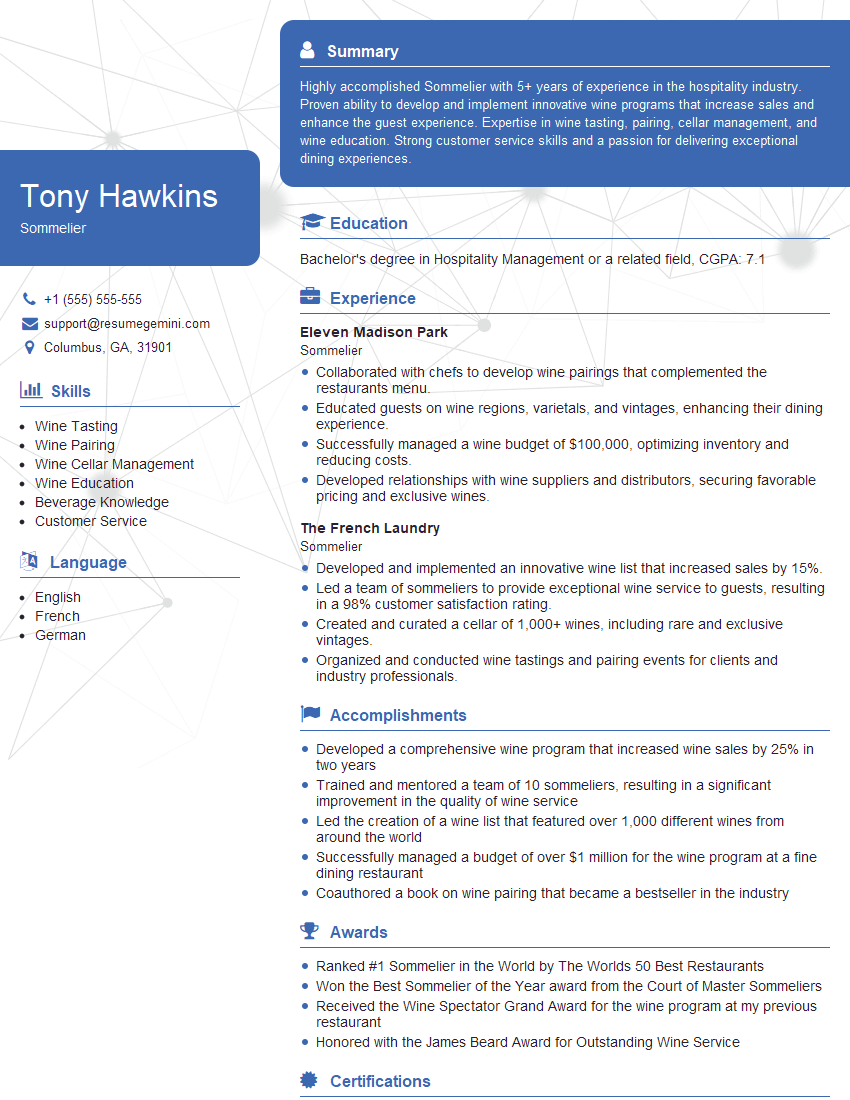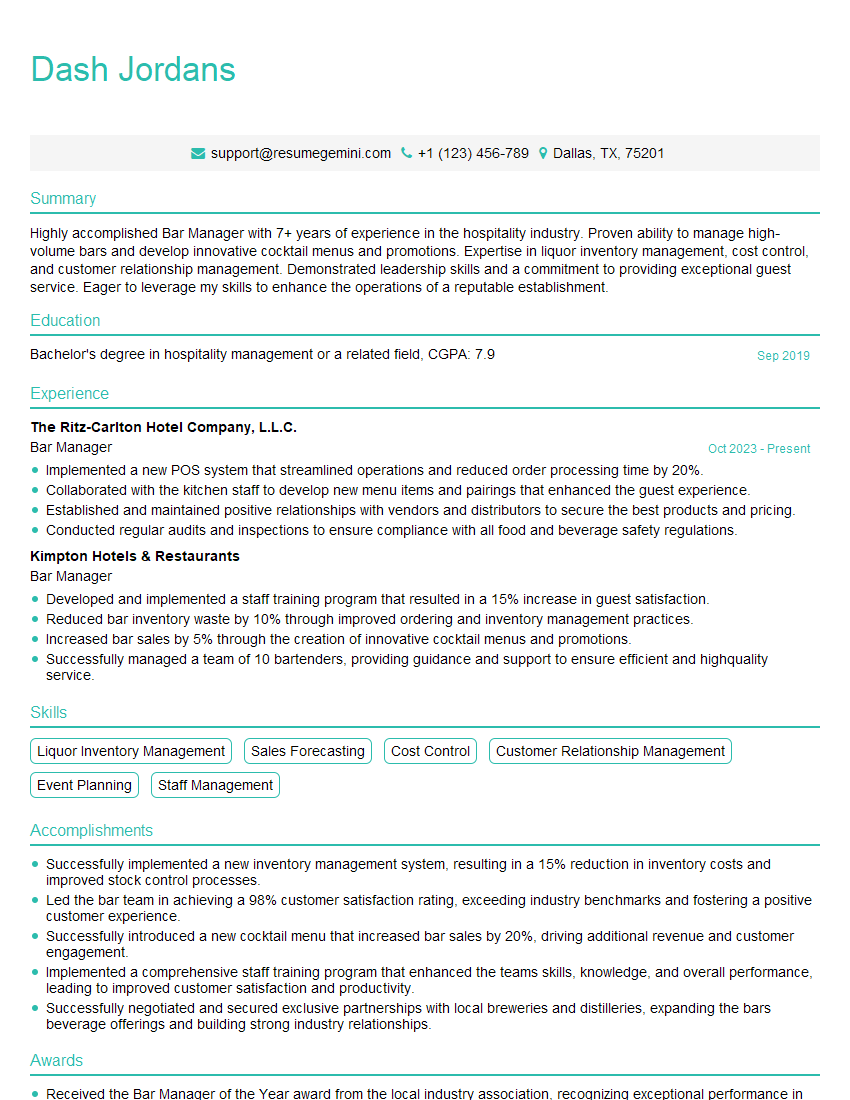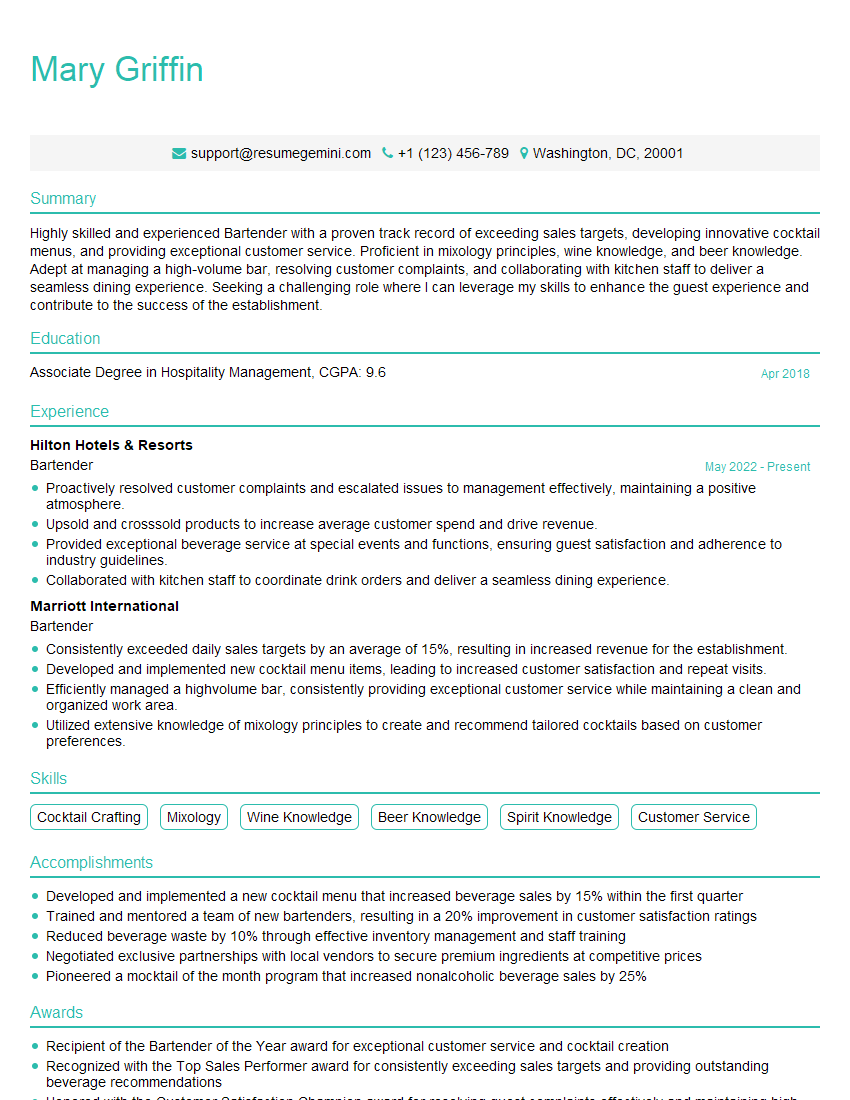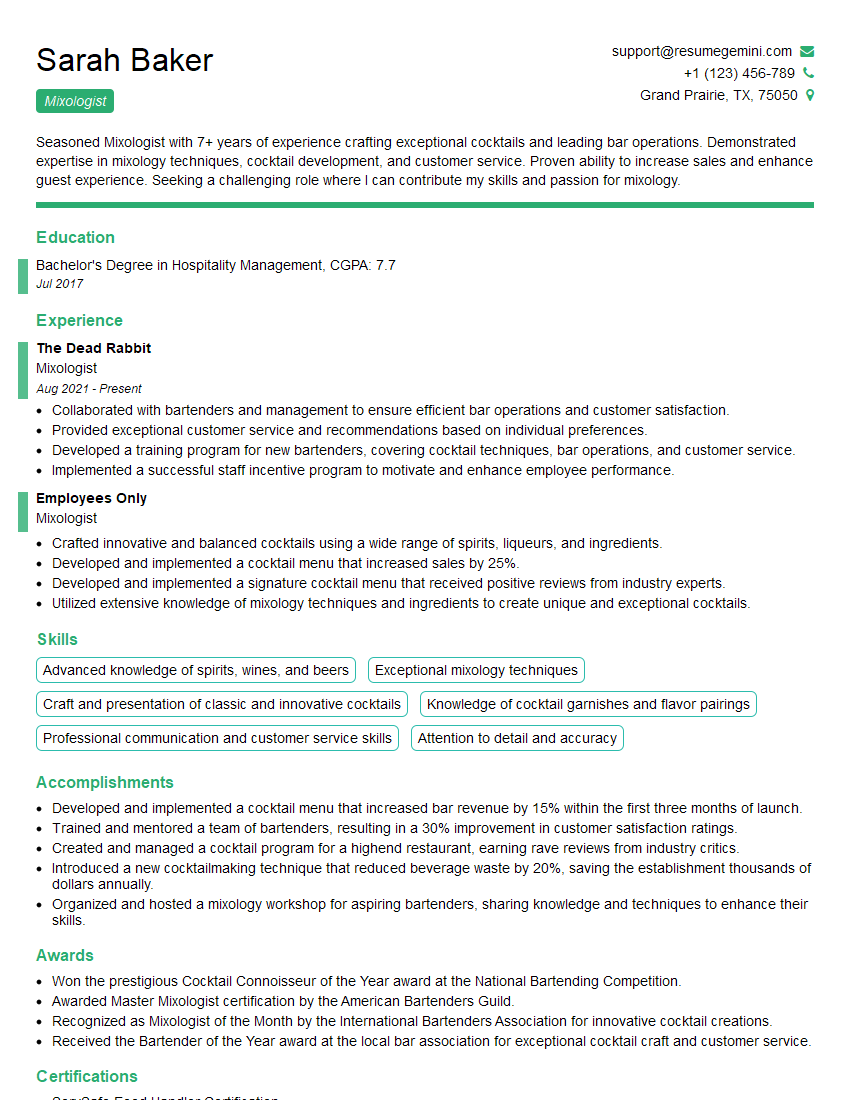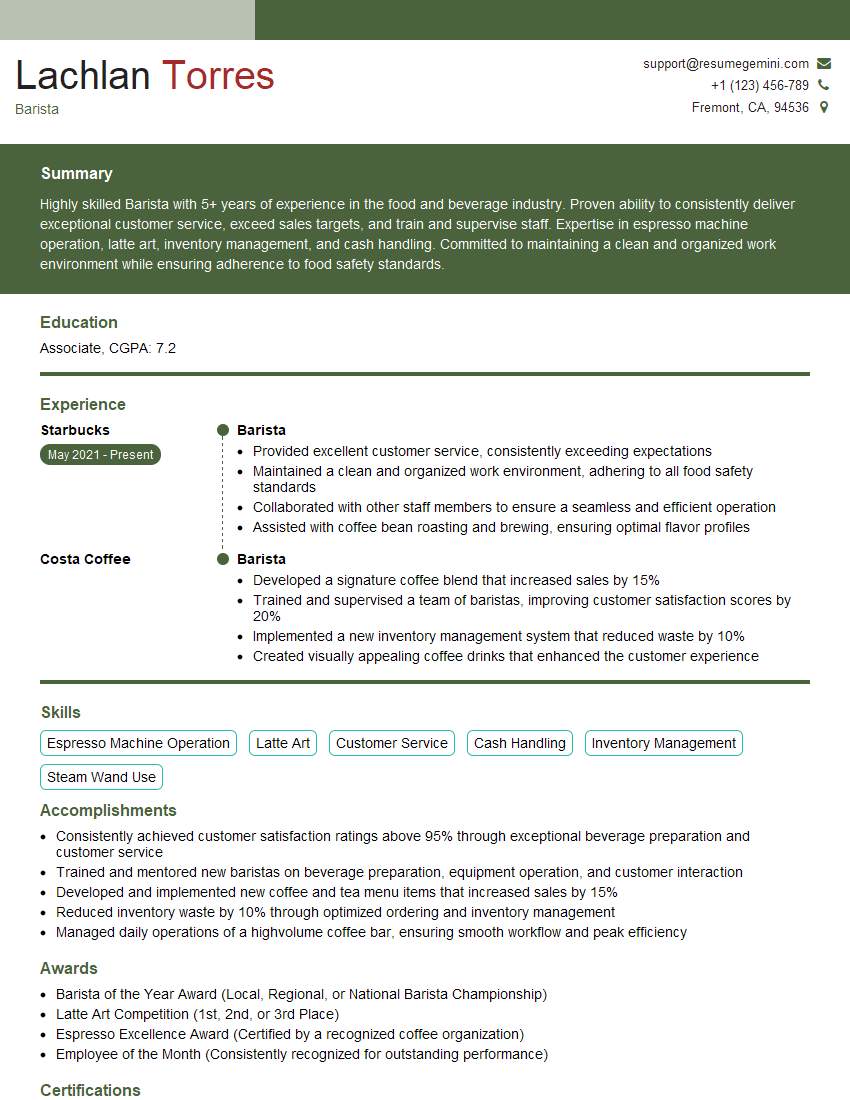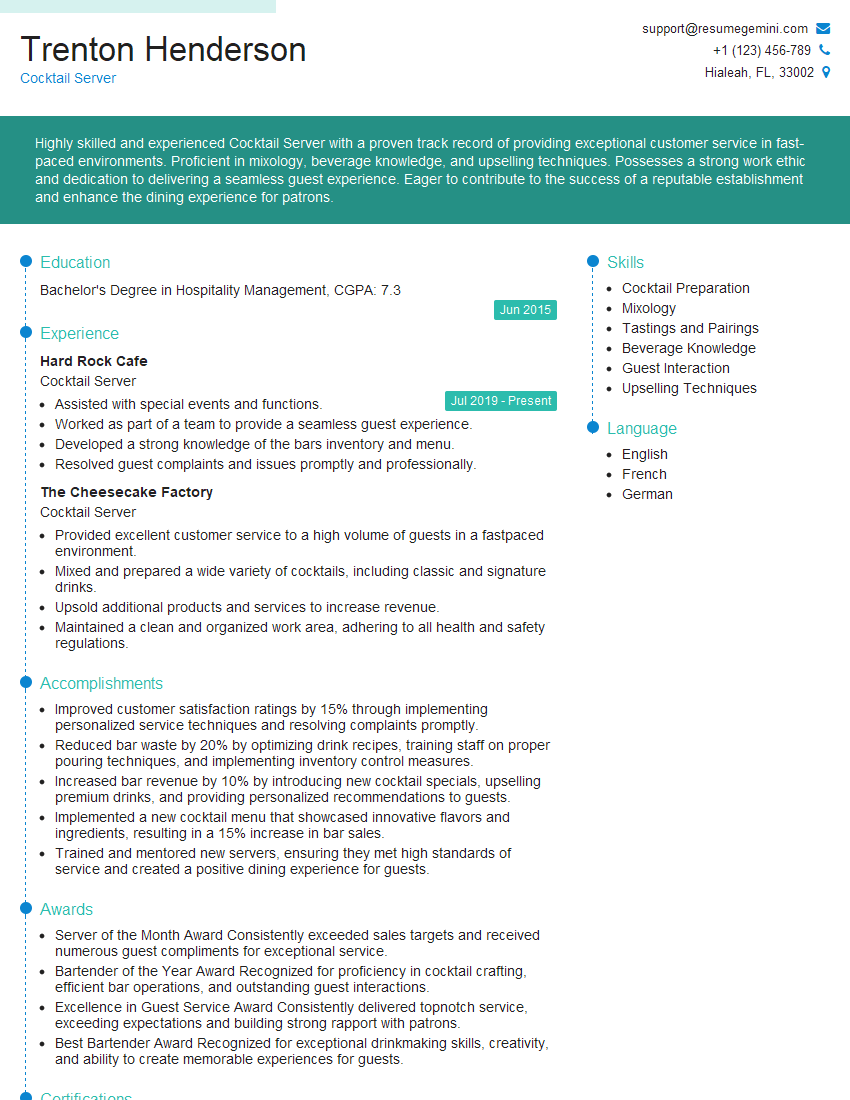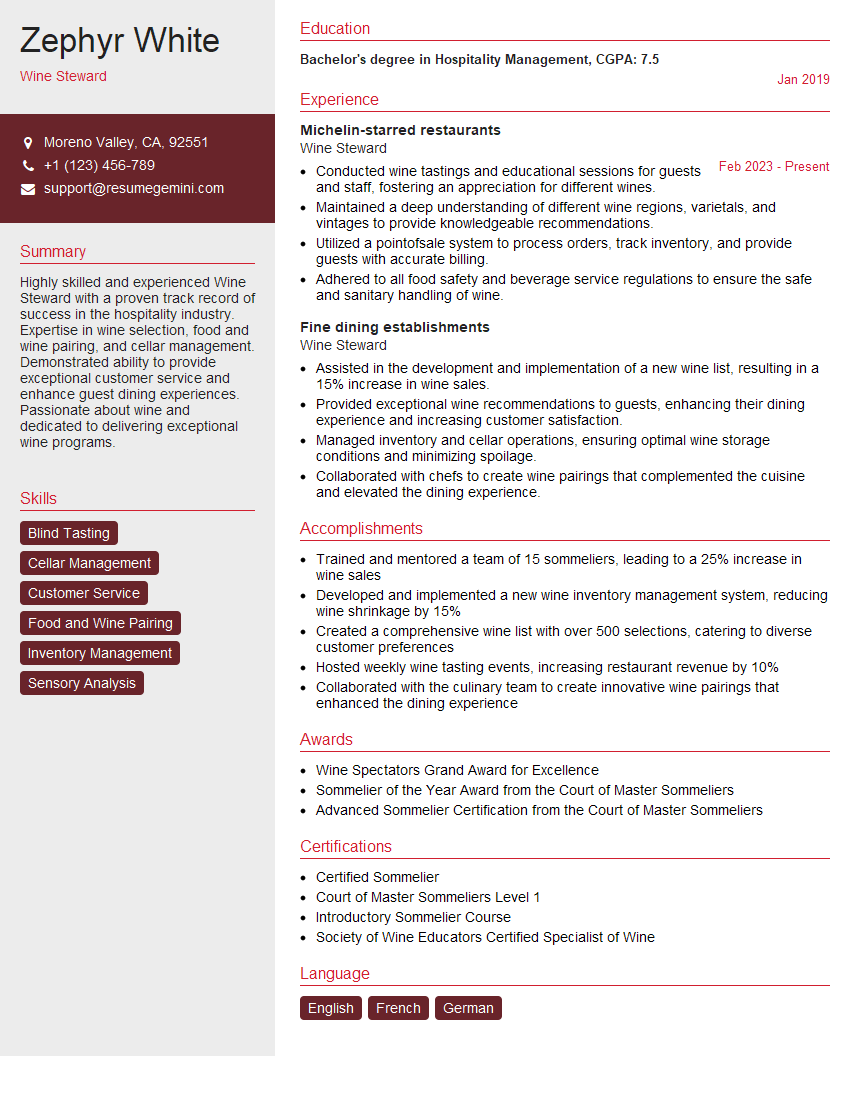Cracking a skill-specific interview, like one for Providing personalized drink recommendations to patrons, requires understanding the nuances of the role. In this blog, we present the questions you’re most likely to encounter, along with insights into how to answer them effectively. Let’s ensure you’re ready to make a strong impression.
Questions Asked in Providing personalized drink recommendations to patrons Interview
Q 1. Describe your experience crafting personalized drink recommendations.
Crafting personalized drink recommendations is an art and science. It involves understanding the customer’s palate, dietary needs, and the occasion, then seamlessly translating that understanding into a delightful beverage experience. It’s about more than just taking an order; it’s about creating a memorable moment.
My approach involves a multi-step process: initially gauging the customer’s preferences through conversation, then suggesting drinks that align with those preferences and any stated constraints. Finally, I offer tailored explanations for why I’ve made the recommendations, increasing customer confidence and satisfaction.
Q 2. How do you identify a customer’s preferences for drinks?
Identifying a customer’s preferences requires keen observation and skillful questioning. I start with open-ended questions like, “What kind of drinks do you usually enjoy?” or “Do you have a preference for sweet, sour, bitter, or something else entirely?” This allows them to guide the conversation. I pay attention to their body language and any cues they give about their taste. For example, someone who orders a spicy dish might appreciate a drink with a bit of heat or a citrusy note to cut through the spice. I also note if they’re drinking anything else, and I try to incorporate that into my next recommendation.
Subtle cues like the clothing they are wearing (formal vs. casual), the time of day, and the overall atmosphere of the restaurant also help me infer preferences. For example, a customer in formal attire may prefer a sophisticated cocktail, while someone on a casual date might appreciate a lighter, refreshing beverage.
Q 3. Explain your process for suggesting drinks based on dietary restrictions.
Dietary restrictions require a meticulous approach. My process begins with explicitly asking about any allergies, intolerances, or dietary choices (e.g., vegan, vegetarian, gluten-free, low-sugar). Once I have this information, I cross-reference it with my menu and knowledge of ingredients. If a customer has a nut allergy, for instance, I carefully check every ingredient in my drink suggestions. For someone who’s avoiding sugar, I’d focus on drinks made with natural sweeteners like agave or stevia or suggest unsweetened options.
I always double-check ingredient lists with the customer if there’s any ambiguity, and I’m transparent about any potential cross-contamination risks, especially in a busy environment. Transparency and careful consideration are paramount.
Q 4. How do you handle a customer who is unsure what to order?
Handling an indecisive customer requires a patient and guided approach. I begin by narrowing down the options with engaging questions. I might ask: “Are you in the mood for something refreshing, something bold, or something comforting?” or “Do you prefer something fruity, creamy, or something with a more complex flavor profile?” This helps them articulate their preferences.
If they’re still unsure, I’ll offer a few curated suggestions based on my experience and knowledge of popular choices. For instance, I might suggest a classic cocktail like a Mojito for its refreshing quality or a simple, well-balanced drink like a glass of wine or a non-alcoholic sparkling cider. I often explain the taste profiles of each suggestion to help them make an informed decision.
Q 5. What are some common drink pairings with specific foods?
Drink pairings with food are a crucial aspect of enhancing the dining experience. Here are some classic examples:
- Spicy food (e.g., Indian curry): A light, crisp lager or a fruity, slightly tart beer can cut through the heat. Similarly, a refreshing mango lassi or a citrus-forward cocktail can work well.
- Rich, fatty dishes (e.g., steak): A full-bodied red wine, such as Cabernet Sauvignon or Merlot, complements the richness. Alternatively, a strong whiskey or a dark stout beer can also create a delicious contrast.
- Seafood (e.g., grilled salmon): Crisp white wines like Sauvignon Blanc or Pinot Grigio are classic pairings. Light-bodied beers or even a refreshing cucumber cooler can also work effectively.
- Cheese (e.g., creamy brie): A light-bodied red wine or a dessert wine like Sauternes are usually excellent matches. Sweet wines balance the richness of the cheese.
The key is to consider the intensity and flavors of both the food and the beverage to create a harmonious combination.
Q 6. How do you stay up-to-date on current beverage trends?
Staying updated on beverage trends is an ongoing process. I regularly read trade publications such as Wine Spectator and Beverage Dynamics. I also subscribe to industry newsletters and follow influential bartenders and mixologists on social media platforms like Instagram and TikTok. Attending industry events, workshops, and conferences provides valuable insights into new techniques and innovative drinks.
Furthermore, I actively engage with online forums and communities dedicated to mixology and beverage trends, allowing me to observe evolving tastes and preferences directly from consumers. Experimentation in my own practice, coupled with ongoing learning, ensures that I’m always ahead of the curve.
Q 7. Describe a time you had to create a drink for a customer with unique preferences.
I once had a customer who was celebrating a significant milestone and wanted a drink that reflected both her adventurous spirit and her appreciation for delicate flavors. She mentioned a love for lavender and a dislike for overly sweet drinks. She also noted that she was celebrating a recent success in the field of astrophysics.
I decided to create a custom cocktail I called the “Cosmic Lavender Fizz.” I infused vodka with fresh lavender, adding a touch of elderflower liqueur for a subtle floral sweetness. I then topped it with sparkling wine and a few fresh raspberries for a visual touch reminiscent of constellations. The result was a light, elegant cocktail that captured her adventurous spirit with a delicate, sophisticated flavor profile.
The customer was absolutely thrilled with the result, and the experience reinforced the importance of active listening and creative problem-solving in crafting personalized drink recommendations.
Q 8. What are your go-to recommendations for different occasions (e.g., celebratory, relaxing)?
My drink recommendations are highly occasion-dependent. For celebrations, I lean towards celebratory cocktails like French 75s (gin, champagne, lemon, sugar) or festive spritzes – something visually appealing and celebratory. The French 75, for example, offers a sophisticated and celebratory feel with its bubbly effervescence. Alternatively, a vibrant Paloma (tequila, grapefruit soda, lime) offers a fun, energetic vibe perfect for a casual party. For a relaxing evening, I suggest something smoother and less stimulating. A classic Old Fashioned (whiskey, sugar, bitters, orange) or a well-made Negroni (gin, vermouth rosso, Campari) provide sophisticated complexity without being overly intense. For a lighter, more calming option, a glass of Pinot Noir (a lighter-bodied red wine known for its earthiness) or a crisp Sauvignon Blanc (a dry white wine with citrus notes) are excellent choices. The key is understanding the atmosphere and desired mood.
Q 9. How do you adapt your recommendations to different customer demographics?
Adapting recommendations requires careful consideration of several factors. Age plays a significant role; I would never offer a strong cocktail to a minor, obviously. Instead, I might suggest a mocktail with similar flavors or a light fruit juice. For older patrons, I might offer something more classic and sophisticated, taking into account their potential preference for less sweet or more complex flavors. Lifestyle choices also matter; a health-conscious individual might appreciate a light spritzer or a non-alcoholic craft beverage. Similarly, someone who prefers less-sweet drinks might appreciate a dry martini or a wine with low residual sugar. I also take into account cultural background – some cultures have stronger preferences for certain types of alcohol or flavor profiles. It’s about thoughtful observation and engaging in a conversation to understand their preferences, rather than making assumptions based on demographics alone.
Q 10. Explain your knowledge of various spirits, wines, and beers.
My knowledge encompasses a wide range of spirits, wines, and beers. In spirits, I’m comfortable discussing various whiskeys (Scotch, Bourbon, Irish), gins, vodkas, rums, tequilas, and liqueurs, understanding their production methods, flavor profiles, and ideal pairings. With wines, my expertise extends to understanding varietals, regions, and vintages. I can explain the differences between a Cabernet Sauvignon from Napa Valley and a Merlot from Bordeaux, for instance, discussing the nuances of soil, climate, and winemaking techniques that shape their unique characteristics. In beer, my understanding covers various styles – from lagers and ales to stouts and IPAs – encompassing different brewing processes, hop varieties, and resulting flavor profiles. I am also well-versed in the current craft beer trends and can suggest local or imported options based on a customer’s preferences.
Q 11. How do you handle customer complaints about a drink recommendation?
Handling customer complaints is crucial for maintaining customer satisfaction. My first step is always to apologize sincerely and actively listen to their concerns without interruption. I’ll then attempt to understand the reason for their dissatisfaction – was the drink improperly made? Did it not meet their expectations in terms of taste or strength? Once the issue is identified, I offer a solution. This could involve remaking the drink, offering a replacement drink (perhaps one better suited to their preferences), or even offering a discount or complimentary appetizer. The goal is to turn a negative experience into a positive one by demonstrating my commitment to customer service. Documenting the issue and resolution is also important for future improvement.
Q 12. How familiar are you with non-alcoholic beverage options?
I’m very familiar with non-alcoholic beverage options and consider them essential, especially given growing interest in health and wellness. My knowledge spans beyond simple juices and sodas; I’m well-versed in sophisticated non-alcoholic cocktails, mocktails, and craft beverages. I can suggest unique combinations of fresh juices, herbs, and spices to create flavorful and visually appealing alternatives. I also understand the growing market of non-alcoholic spirits, which aim to mimic the taste and complexity of alcoholic drinks without the alcohol content, and I can guide customers to appropriate options based on their preferences. Furthermore, I stay updated on new trends in the non-alcoholic beverage industry to offer patrons the most creative and diverse options.
Q 13. What are some strategies for upselling beverages?
Upselling involves subtly guiding customers towards higher-priced or premium options without being pushy. One strategy is suggesting pairings. If a customer orders a certain type of wine, I might suggest a cheese or charcuterie board that complements its flavors. Alternatively, I might describe the unique characteristics of a premium spirit compared to a standard one, highlighting its higher quality ingredients or unique production methods. Offering tasting notes can also help; describing the subtle nuances of a particular wine or cocktail can pique a customer’s interest and encourage them to opt for a more premium choice. Finally, presenting options in a way that highlights value, such as emphasizing the rare ingredients or unique experience of a particular drink, can encourage customers to consider a higher-priced option. Ultimately, effective upselling is about providing informed recommendations and enhancing the customer’s overall experience.
Q 14. Describe your experience with different cocktail-making techniques.
My experience with cocktail-making techniques is extensive. I’m proficient in various mixing methods, from shaking and stirring to muddling and layering. I understand the importance of proper ingredient ratios and techniques to achieve the desired balance of flavors and textures. I’m familiar with classic cocktail-making methods and also up-to-date on modern techniques like using sous vide or employing specialized tools to improve consistency and quality. My skills include creating custom cocktails tailored to individual customer preferences, incorporating fresh ingredients and unique flavor combinations. I’m also adept at creating visually appealing cocktails using garnishes and presentation techniques that enhance the overall drinking experience. I treat cocktail making as both a science and an art form, striving for both precision and creativity.
Q 15. How do you balance customer preferences with the bar’s drink menu?
Balancing customer preferences with the bar’s menu is a crucial skill. It’s about finding that sweet spot where you satisfy the guest’s desires while working within the constraints of available ingredients and the establishment’s offerings. I achieve this through active listening and suggestive selling.
Active Listening: I start by carefully listening to the customer’s requests, noting their preferred spirits, mixers, sweetness levels, and any dietary restrictions or allergies. For example, if a customer says they like fruity cocktails but are allergic to strawberries, I can suggest a delicious alternative using raspberries or blueberries.
Suggestive Selling: Once I understand their preferences, I can subtly guide them towards options on our menu that align with their tastes. If someone enjoys gin, I might suggest our signature gin cocktail, highlighting its unique ingredients or flavor profile. This approach respects their choices while showcasing the bar’s expertise and unique offerings. If a requested drink is unavailable, I offer comparable alternatives, emphasizing similar flavor profiles or spirit bases. This avoids disappointing the customer and maintains a positive interaction.
Career Expert Tips:
- Ace those interviews! Prepare effectively by reviewing the Top 50 Most Common Interview Questions on ResumeGemini.
- Navigate your job search with confidence! Explore a wide range of Career Tips on ResumeGemini. Learn about common challenges and recommendations to overcome them.
- Craft the perfect resume! Master the Art of Resume Writing with ResumeGemini’s guide. Showcase your unique qualifications and achievements effectively.
- Don’t miss out on holiday savings! Build your dream resume with ResumeGemini’s ATS optimized templates.
Q 16. How do you maintain professionalism while interacting with intoxicated patrons?
Maintaining professionalism with intoxicated patrons requires a delicate balance of empathy and firmness. My approach prioritizes safety and de-escalation.
Observation and Assessment: I carefully observe the patron’s behavior, looking for signs of excessive intoxication. This allows me to preemptively adjust my approach. I speak clearly and slowly, using simple language and avoiding complex orders.
Refusal of Service: If a patron is visibly intoxicated and ordering more drinks poses a safety risk, I politely but firmly refuse service, explaining that it’s against our policy to serve overly intoxicated individuals for their safety and well-being. This is done calmly and respectfully, avoiding confrontation. If necessary, I alert management or security personnel.
De-escalation Techniques: I use calming and reassuring language, avoiding arguments or confrontations. I focus on offering non-alcoholic options like water or soda to help the patron rehydrate. Maintaining a calm, professional demeanor, even when faced with aggressive behavior, helps de-escalate potentially tense situations.
Q 17. Explain your knowledge of drink preparation and safety guidelines.
My knowledge of drink preparation encompasses a wide range of cocktails, mixed drinks, and non-alcoholic beverages. I am proficient in using various tools and equipment, including shakers, strainers, muddlers, and jiggers to ensure precise measurements and consistent quality. I understand the importance of proper hygiene and sanitation in drink preparation, following all safety guidelines.
Safety Guidelines: I strictly adhere to safety regulations regarding the handling of alcohol, including checking IDs to prevent underage drinking. I am aware of the dangers of cross-contamination and ensure all equipment and surfaces are thoroughly cleaned and sanitized. I am trained in safe alcohol service practices and know how to recognize and respond to signs of intoxication. I also understand the importance of proper storage of alcohol to prevent spoilage and maintain quality. Knowing the specific alcohol content (ABV) of each beverage is crucial for responsible service.
Preparation Techniques: I am familiar with different preparation methods, such as shaking, stirring, muddling, and layering, and know when to apply each technique to achieve the desired texture and presentation. I can also adjust recipes to meet customer preferences while maintaining balance and flavor harmony.
Q 18. How do you manage your time efficiently during peak hours?
Managing time effectively during peak hours is about prioritization, organization, and teamwork. My approach involves a combination of efficient order taking, streamlined preparation, and effective communication.
Efficient Order Taking: I use clear and concise communication to take orders quickly and accurately, avoiding unnecessary delays. I often pre-batch common ingredients or components of several cocktails to speed up the preparation process, like pre-mixing sour mixes or simple syrups.
Streamlined Preparation: I utilize a system where I prioritize orders based on complexity and urgency. Simple drinks are prepared first, while more elaborate cocktails are handled in stages to ensure everything is ready to serve promptly and efficiently. This approach helps maintain order and minimizes waiting times.
Teamwork and Communication: During peak hours, seamless teamwork is essential. I communicate effectively with other bartenders and servers to coordinate tasks and ensure smooth operations. This includes sharing workload, assisting colleagues, and ensuring that all customers are served in a timely manner.
Q 19. Describe your experience working under pressure in a fast-paced environment.
I thrive under pressure in fast-paced environments. My experience in busy bars has taught me to stay calm, focused, and efficient even when the pressure is high. One example was during a major sporting event where the bar was exceptionally crowded. We had to serve a large number of patrons quickly while ensuring consistent quality and accuracy. I maintained a steady pace, used my organizational skills, and seamlessly collaborated with my colleagues to keep the service flowing smoothly and efficiently. The experience highlighted my ability to remain composed under pressure and adapt to demanding situations.
Strategies: I use techniques like prioritizing tasks, maintaining a calm demeanor, and relying on my training to ensure accuracy and efficiency. This involves accurately managing multiple orders simultaneously without sacrificing the quality or speed of service.
Q 20. How do you handle difficult or demanding customers?
Handling difficult customers requires patience, empathy, and effective communication skills. My approach focuses on active listening, understanding their concerns, and finding mutually acceptable solutions.
Active Listening: I allow the customer to fully express their concerns without interruption, actively listening to understand their perspective. This shows respect and helps de-escalate the situation. I validate their feelings and express empathy to establish rapport.
Problem Solving: Once I fully understand the issue, I offer solutions that address their concerns within the limitations of our establishment’s policies. This might involve remaking a drink, offering a discount, or explaining the reasons behind certain policies.
Escalation: In situations I cannot resolve, I alert my manager to ensure the situation is handled appropriately and professionally, protecting both the customer and the establishment’s reputation.
Q 21. How do you ensure the accuracy of drink orders?
Ensuring the accuracy of drink orders involves careful attention to detail throughout the entire process. From order taking to preparation and delivery, I employ several strategies to maintain accuracy.
Order Verification: I repeat the order back to the customer to confirm accuracy before starting preparation. This simple step minimizes misunderstandings and avoids mistakes.
Precise Measurements: I use standardized measuring tools like jiggers to ensure consistent and accurate proportions of ingredients. This is especially important for maintaining quality and consistency across all drinks.
Double Checking: Before serving, I visually inspect the drink to ensure it aligns with the order and meets our quality standards. This final check helps catch any errors before they reach the customer.
Customer Feedback: I encourage customers to provide feedback about their drinks. This is a vital part of the process as it allows for immediate correction of any errors and continuous improvement in service.
Q 22. Explain your understanding of alcohol awareness and responsible service.
Alcohol awareness and responsible service are paramount in my profession. It’s not just about serving drinks; it’s about ensuring the safety and well-being of patrons. My understanding encompasses recognizing signs of intoxication, such as slurred speech, impaired coordination, or aggressive behavior. I’m trained to refuse service to visibly intoxicated individuals or those who appear underage, adhering strictly to legal drinking age regulations. I believe in proactively preventing alcohol-related incidents through careful observation and interaction with guests. For example, I might offer water or food alongside alcoholic beverages, pace drinks, and engage in friendly conversation to gauge a patron’s condition. Responsible service also means being familiar with local laws and regulations pertaining to alcohol sales, and knowing when and how to contact emergency services if necessary. It’s about being a responsible member of the community and contributing to a safe and enjoyable environment for everyone.
Q 23. How do you maintain cleanliness and hygiene standards at the bar?
Maintaining cleanliness and hygiene is non-negotiable in a bar setting. It’s crucial for both the health of patrons and the reputation of the establishment. My daily routine includes regularly wiping down surfaces, cleaning glassware thoroughly (using a dedicated sanitizer), and ensuring that the ice machine is regularly cleaned and maintained. I follow strict procedures for handling food and beverages, including proper handwashing, use of gloves when appropriate, and adherence to food safety guidelines. Furthermore, I ensure all equipment is in clean and proper working order, from the ice machine to the cocktail shakers. I proactively address spills immediately to prevent accidents and maintain a spotless environment. Regular deep cleaning schedules are crucial, and I’m always keen to ensure everything meets the highest standards of hygiene. For instance, I ensure all bar mats and surfaces are cleaned after every shift, and any potential hazards are swiftly mitigated.
Q 24. What is your experience with POS (point of sale) systems?
I’m proficient in using various POS (Point of Sale) systems. My experience ranges from simple cash register systems to more sophisticated software that integrates inventory management, sales tracking, and employee scheduling. I’m adept at processing transactions quickly and accurately, managing payments (cash, credit, debit), and generating reports on sales data. For instance, I’m comfortable using systems like Micros, Toast, and Square, and can easily learn new systems as needed. My skills include accurately entering orders, handling returns and refunds efficiently, and reconciling the cash drawer at the end of a shift. I understand the importance of accurate data entry for inventory control, tracking sales trends, and managing costs effectively. A strong understanding of POS systems is vital for smooth operations and accurate financial reporting within any establishment.
Q 25. How do you contribute to a positive and efficient team environment?
Contributing to a positive and efficient team environment is a priority for me. I believe in open communication, collaboration, and mutual respect. I’m always willing to help colleagues, share my knowledge, and assist with tasks as needed, whether it’s assisting during peak hours or helping to restock supplies. I view teamwork as essential for providing excellent customer service and maintaining a smooth workflow. For example, I might assist a colleague with a difficult customer or take on additional responsibilities if someone is short-staffed. Proactive communication is key—I’m comfortable bringing up issues or suggesting improvements to processes to enhance efficiency and morale. A strong team spirit creates a more pleasant and productive working atmosphere for everyone.
Q 26. What is your experience managing inventory and ordering supplies?
Managing inventory and ordering supplies requires attention to detail and organizational skills. My experience includes monitoring stock levels, identifying low-stock items, and placing timely orders with suppliers to avoid running out of essential products. I’m proficient at using inventory management software to track stock, analyze sales data, and predict future demand. For instance, I can use data to understand which liquors are selling fastest, and adjust orders accordingly. I also ensure proper storage and rotation of stock to minimize waste and maintain product quality. I negotiate with suppliers to secure favorable pricing and ensure timely delivery. Efficient inventory management is crucial for controlling costs and ensuring the smooth operation of the bar.
Q 27. How do you handle cash transactions and maintain accurate records?
Handling cash transactions accurately and maintaining detailed records are fundamental aspects of my role. I’m meticulous in processing cash payments, ensuring correct change is given, and promptly recording all transactions. I’m comfortable balancing the cash drawer at the end of each shift and reconciling it with the POS system data. Any discrepancies are investigated and resolved immediately. I follow all security procedures to protect cash from theft and maintain accurate accounting records. Maintaining accurate records is vital for tax purposes and for the overall financial health of the establishment. I regularly review sales data and identify areas for improvement or potential inconsistencies. The accuracy and security of financial transactions are paramount for a successful and trustworthy business.
Q 28. What are your salary expectations for this role?
My salary expectations are commensurate with my experience and skills, and are in line with the industry standard for a similar role in this market. I am open to discussing a competitive compensation package that reflects my value and contribution to the team.
Key Topics to Learn for Providing Personalized Drink Recommendations to Patrons Interview
- Understanding Palates and Preferences: Learn to identify subtle cues from patrons to gauge their taste profiles (e.g., observing their clothing style, asking open-ended questions about their preferences, and noticing their reactions to menu descriptions).
- Menu Mastery: Develop a thorough understanding of your establishment’s drink menu, including ingredients, flavor profiles, preparation methods, and price points. This includes knowing the differences between various types of alcohol, mixers, and garnishes.
- Suggestive Selling Techniques: Practice effective suggestive selling strategies. Learn how to confidently and naturally offer recommendations that enhance the patron’s experience without being pushy (e.g., offering complementary pairings, highlighting seasonal specials, and upselling based on preferences).
- Handling Dietary Restrictions and Allergies: Become adept at identifying and accommodating dietary restrictions and allergies. Know which drinks are suitable for various dietary needs (e.g., gluten-free, vegan, low-sugar).
- Building Rapport and Customer Service: Develop exceptional customer service skills. Learn how to create a welcoming and engaging atmosphere, build rapport with patrons, and handle difficult situations with grace and professionalism.
- Adaptability and Problem-Solving: Prepare for scenarios where a patron’s request may need adaptation or a creative solution. Practice thinking on your feet and providing thoughtful alternatives.
- Beverage Knowledge and Trends: Stay updated on current beverage trends, popular cocktails, and emerging spirits. Demonstrating knowledge of industry developments shows initiative and passion.
Next Steps
Mastering the art of personalized drink recommendations is crucial for career advancement in the hospitality industry. It showcases excellent customer service, product knowledge, and sales skills – all highly valued by employers. To significantly boost your job prospects, create an ATS-friendly resume that highlights these skills. ResumeGemini is a trusted resource to help you build a professional and effective resume. Examples of resumes tailored to this specific skill set are provided to guide you. Take the time to craft a compelling resume that showcases your abilities – it’s your first impression on potential employers.
Explore more articles
Users Rating of Our Blogs
Share Your Experience
We value your feedback! Please rate our content and share your thoughts (optional).
What Readers Say About Our Blog
Dear Sir/Madam,
Do you want to become a vendor/supplier/service provider of Delta Air Lines, Inc.? We are looking for a reliable, innovative and fair partner for 2025/2026 series tender projects, tasks and contracts. Kindly indicate your interest by requesting a pre-qualification questionnaire. With this information, we will analyze whether you meet the minimum requirements to collaborate with us.
Best regards,
Carey Richardson
V.P. – Corporate Audit and Enterprise Risk Management
Delta Air Lines Inc
Group Procurement & Contracts Center
1030 Delta Boulevard,
Atlanta, GA 30354-1989
United States
+1(470) 982-2456
